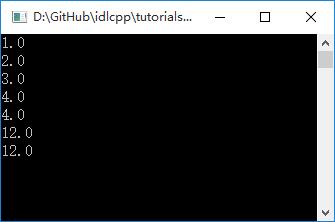C++混合编程之idlcpp教程Python篇
Posted kunana
tags:
篇首语:本文由小常识网(cha138.com)小编为大家整理,主要介绍了C++混合编程之idlcpp教程Python篇相关的知识,希望对你有一定的参考价值。
上一篇在这 C++混合编程之idlcpp教程Python篇(3)
第一篇在这 C++混合编程之idlcpp教程(一)
与前面的工程相似,工程PythonTutorial2中,同样加入了三个文件 PythonTutorial2.cpp, Tutorial2.i, tutorial2.py。其中PythonTutorial2.cpp的内容基本和PythonTutorial1.cpp雷同,不再赘述。首先看一下Tutorial2.i的内容:
namespace tutorial { struct Point { float x; float y; nocode Point(); nocode Point(float a, float b); #{ Point() {} Point(float a, float b) { x = a; y = b; } #} }; struct Rectangle { Point m_min; Point m_max; float left set get; float right set get; nocode float bottom set get; nocode float top set get; nocode float area get; nocode float getArea(); Rectangle(const Point& min, const Point& max); Rectangle(); nocode Rectangle(const Rectangle& pt); #{ void set_bottom(float bottom) { m_min.y = bottom; } float get_bottom() { return m_min.y; } void set_top(float top) { m_max.y = top; } float get_top() { return m_max.y; } float get_area() { return (m_max.x - m_min.x)*(m_max.y - m_min.y); } float getArea() { return (m_max.x - m_min.x)*(m_max.y - m_min.y); } #} }; #{ inline Rectangle::Rectangle(const Point& min, const Point& max) : m_min(min), m_max(max) { } inline Rectangle::Rectangle() {} inline float Rectangle::get_left() { return m_min.x; } inline void Rectangle::set_left(float left) { m_min.x = left; } inline float Rectangle::get_right() { return m_max.x; } inline void Rectangle::set_right(float right) { m_max.x = right; } #} }
在这里仍然有struct Point。与PythonTutorial1中的struct Point相比,除了原来的默认构造函数外,多了一个带两个参数的构造函数
Point(float a, float b);
两个构造函数都在meta: 段中,所以idlcpp不会在Tutorial2.h中生成对应的函数声明,所在直接在后面的#{#}写上构造函数的实现代码,这些代码会插入到Tutorial2.h中的对应位置。当然也可以不使用meta:,这样的话这两个构造函数的声明部分就会出现在Tutorial2.h的struct Point中,那么实现代码就要写在外面了。在struct Point后添加了一个新的类型struct Rectangle。前两行
Point m_min;
Point m_max;
声明了两个数据成员。然后是
float left set get;
float right set get;
这里又出现了新的语法:属性。属性语法来自于C#。形式为: 类型 + 名称 + 可选的set和get。在C++中实际上是生成了两个对应的成员函数,函数名分别为set_ + 属性名称,get_ + 属性名称,比如为属性left生成的两个成员函数为:void set_left(float)和float get_left()。然后还有三个属性的声明
float bottom set get;
float top set get;
float area get;
其中属性area是只读属性,即只生成float get_area()成员函数。然后是
float getArea();
这是一个成员函数,在C++生成中的函数形式和这里是一样的。然后是
Rectangle(const Point& min, const Point& max);
Rectangle();
nocode Rectangle(const Rectangle& pt);
此处一共三个构造函数,其中最后一个是拷贝构造函数,对于此类来说,拷贝构造函数可以不写。所以加了nocode前缀。于是在头文件只会有两个构造函数声明,但是在元数据中静态函数New共有三个重载函数。分别对于上面三个构造函数。
后面就是具体函数的实现代码。都放在#{#}中以便复制到头文件中。
编译后生成的Tutorial2.h的内容如下:
//DO NOT EDIT THIS FILE, it is generated by idlcpp
//http://www.idlcpp.org
#pragma once
#include "./Tutorial2.h"
namespace tutorial{ struct Rectangle; }
namespace tutorial
{
struct Point
{
public:
float x;
float y;
public:
static Point* New();
static Point* New(float a,float b);
static Point* NewArray(unsigned int count);
Point()
{}
Point(float a, float b)
{
x = a;
y = b;
}
};
struct Rectangle
{
public:
Point m_min;
Point m_max;
void set_left( float);
float get_left();
void set_right( float);
float get_right();
Rectangle(const Point& min,const Point& max);
Rectangle();
public:
static Rectangle* New(const Point& min,const Point& max);
static Rectangle* New();
static Rectangle* NewArray(unsigned int count);
static Rectangle* Clone(const Rectangle& pt);
void set_bottom(float bottom)
{
m_min.y = bottom;
}
float get_bottom()
{
return m_min.y;
}
void set_top(float top)
{
m_max.y = top;
}
float get_top()
{
return m_max.y;
}
float get_area()
{
return (m_max.x - m_min.x)*(m_max.y - m_min.y);
}
float getArea()
{
return (m_max.x - m_min.x)*(m_max.y - m_min.y);
}
};
inline Rectangle::Rectangle(const Point& min, const Point& max) : m_min(min), m_max(max)
{
}
inline Rectangle::Rectangle()
{}
inline float Rectangle::get_left()
{
return m_min.x;
}
inline void Rectangle::set_left(float left)
{
m_min.x = left;
}
inline float Rectangle::get_right()
{
return m_max.x;
}
inline void Rectangle::set_right(float right)
{
m_max.x = right;
}
}
内容基本上都是和Tutorial2.i中一一对应的
然后看一下脚本tutorial2.py的内容:
import pafpython;
paf = pafpython.paf;
rect1 = paf.tutorial.Rectangle();
rect1.m_min.x = 1;
rect1.m_min.y = 2;
print(rect1.left._);
print(rect1.bottom._);
rect1.right = 3;
rect1.top = 4;
print(rect1.m_max.x._);
print(rect1.m_max.y._);
print(rect1.area._);
rect2 = paf.tutorial.Rectangle(rect1.m_min, paf.tutorial.Point(5,5));
print(rect2.getArea()._);
rect3 = paf.tutorial.Rectangle.New(rect2);
print(rect3.getArea()._);
rect1 = paf.tutorial.Rectangle();
这是rect1 = paf.tutorial.Rectangle.New(); 的简化写法。
后面分别用数据成员和属性来操作rect1。
rect2 = paf.tutorial.Rectangle(rect1.m_min, paf.tutorial.Point(5,5));
调用了Rectangle带参数的构造函数(实际上是静态函数New)。
rect3 = paf.tutorial.Rectangle.New(rect2);
相当于C++中的 Rectangle* rect3 = new Rectangle(*rect2);
编译运行结果如下图:

以上是关于C++混合编程之idlcpp教程Python篇的主要内容,如果未能解决你的问题,请参考以下文章